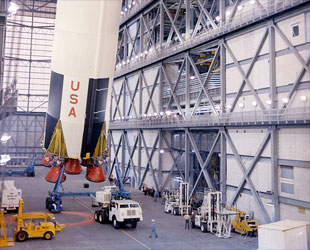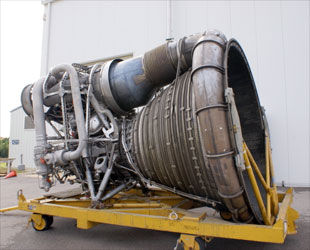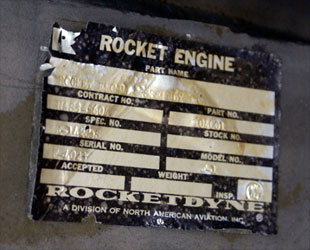Dec. 22, 2008 — Five seconds before the first astronauts left Earth for the moon on Dec. 21, 1968, the rocket they were riding ignited its first stage's five engines. They were the first people to launch atop a Saturn V, and that day 40 years ago at 7:51 a.m. EST (1251 GMT) was the first time those particular five F-1 rocket engines had fired together.
For the Apollo 8 crew of Frank Borman, James Lovell and Williams Anders, for the next 150 seconds, those engines needed to work for their mission — to circle the Moon — to be possible.
And work they did; despite having to burn 2.4 seconds longer than planned to make up for an underperformance, the five 19-foot tall, Rocketdyne-built F-1 engines — each more powerful than all three of today's space shuttle main engines combined — propelled Apollo 8 to 40 miles above the Earth. Their work done, the first stage was jettisoned and allowed to fall back and sink to the ocean floor some 350 miles (560 kilometers) off the Florida coast.
Borman, Lovell and Anders, with the help of their rocket's upper stages and Apollo 8 spacecraft would, of course, succeed, entering lunar orbit on Christmas Eve in 1968, making history as the first to enter the gravitational field of another celestial body. Their flight would be hailed as one of the boldest in all of human history.
The Saturn V rocket used to launch their adventure has long since vanished, having served its purpose, although the third stage continues to travel unseen in heliocentric orbit about the Sun. All that remains of their journey is the command module, on display at the Museum of Science and Industry in Chicago, Illinois.
There exists however another component that was almost part of the Apollo 8 launch vehicle. Lost in plain sight for years, it was recently rediscovered just in time for the 40th anniversary of the Apollo 8 mission.
The (not-so-little) engine that couldn't

Apollo 8's first stage in the Vehicle Assembly Building. (NASA) |
After being assembled at the Michoud Assembly Facility in Louisiana, test fired at NASA's Marshall Space Flight Center in Alabama and shipped back to New Orleans for further testing, Apollo 8's Saturn V first stage departed by barge to Florida on Dec. 23, 1967. It arrived at Kennedy Space Center four days later.
Normally — and for the remainder of the Apollo program — the engine configuration that arrived at the cape would be the contingent that flew when launched. But that wasn't to be for Apollo 8's first stage.
"A problem was discovered in one of the engines," Alan Lawrie, the author of "Saturn" and most recently, "Saturn 1/1B", explained to collectSPACE. A leak in a fuel pump seal was found in one of the outboard engines, requiring its replacement.
"The engine was taken off the stage just seven months before eventual launch and replaced by a spare engine," said Lawrie. "When Apollo 8 lifted off the five F-1 engines had never been fired together before because of this late replacement."
The rejected F-1, known by its serial number F-4023, was returned to Rocketdyne in Los Angeles for servicing. First assembled in 1964 as the 23rd flight-standard F-1 engine, F-4023 was repaired and again declared flight-worthy less than three months before Apollo 8 launched.
"However, the engine was never re-allocated to another stage," said Lawrie. "Instead, it was shipped to Michoud where it was used to verify the effects of long term storage on F-1 engines. It remained at Michoud for over 20 years."
In 1990, the engine was inspected by Rocketdyne before it was moved to Alabama, moving between the Marshall Space Flight Center and U.S. Space and Rocket Center.
"In the intervening period, the historical link between this engine and its planned mission was lost," Lawrie shared.
On your right, you'll see forgotten space history...

F-1 engine F-4203 at Marshall Space Flight Center (Mike Jetzer) |
Mike Jetzer of Germantown, Wisconsin did not know he was going to help rediscover a forgotten piece of Apollo 8 history when he took a bus tour of Marshall Space Flight Center this past October. In fact, he didn't even know he was going to see an F-1 engine.
"As we drove up to a tour stop used to house a plywood and PVC pipe full-scale mockup of the Ares I frustum, interstage, and aft end of the second stage... I noticed a fairly nice-looking F-1 and nozzle extension," wrote Jetzer on his website, heroicrelics.org.
Jetzer, a space history enthusiast, excused himself from touring the mock-up of NASA's next generation crewed launch vehicle to photograph the Apollo program engine.
"This is apparently Building 4205," Jetzer recalled of his location, citing the itinerary he was given during the tour. "The F-1 is approximately equidistant from the building and the nozzle extension, so I was unable to get any full side shots of the engine."
He was however, able to photograph the engine's master ID plate.

The master ID plate on Marshall's F-1 engine (Mike Jetzer) |
"It had peeled off about half-way; I had to straighten it out and push the left-hand side of it back up," he wrote.
The serial number read: F-4023.
Returning from the tour, Jetzer contacted Lawrie, who he knew had been tracking the location of the remaining F-1 engines.
Lawrie in turn contacted Marshall Historic Preservation Officer Ralph Allen, who provided additional photographs "conclusively linking this engine to that first manned Saturn V launch, Apollo 8, 40 years ago," Lawrie stated.
